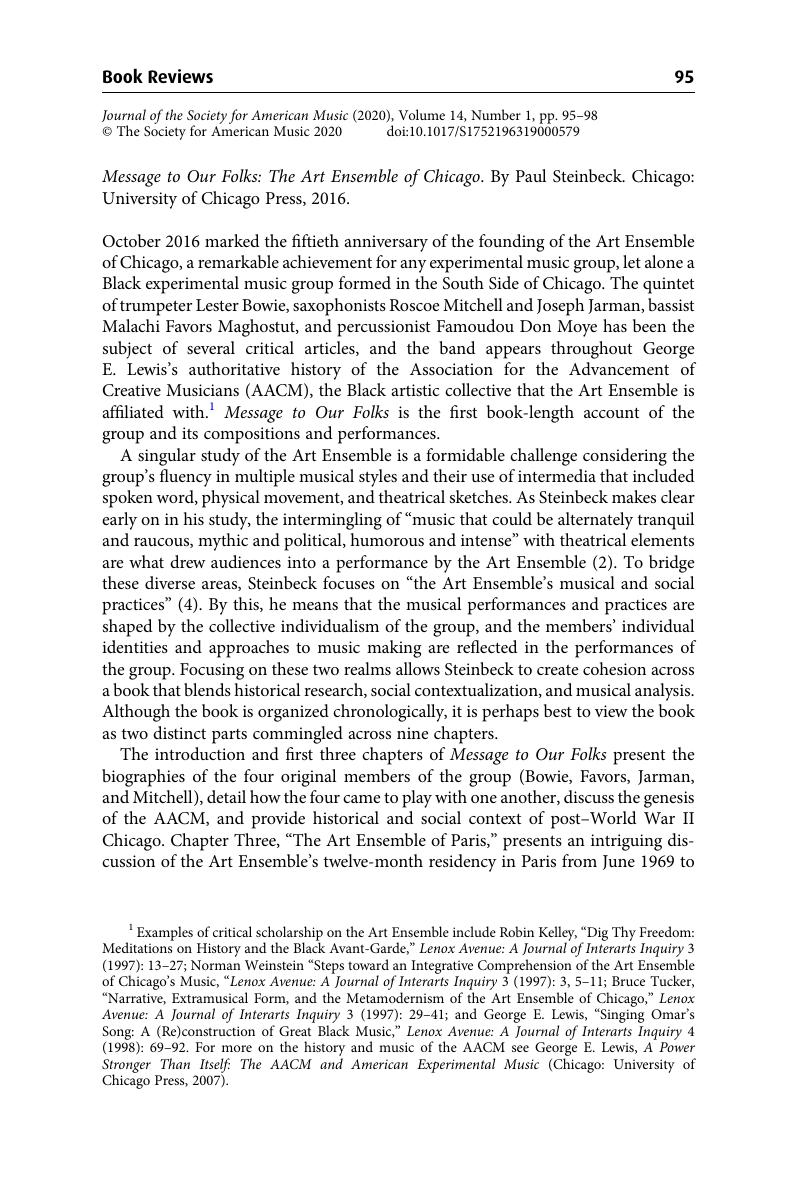No CrossRef data available.
Article contents
Message to Our Folks: The Art Ensemble of Chicago. By Paul Steinbeck. Chicago: University of Chicago Press, 2016.
Published online by Cambridge University Press: 15 January 2020
Abstract

- Type
- Book Review
- Information
- Journal of the Society for American Music , Volume 14 , Special Issue 1: Music Festivals , February 2020 , pp. 95 - 98
- Copyright
- Copyright © The Society for American Music 2020
References
1 Examples of critical scholarship on the Art Ensemble include Kelley, Robin, “Dig Thy Freedom: Meditations on History and the Black Avant-Garde,” Lenox Avenue: A Journal of Interarts Inquiry 3 (1997): 13–27CrossRefGoogle Scholar; Norman Weinstein “Steps toward an Integrative Comprehension of the Art Ensemble of Chicago's Music, “Lenox Avenue: A Journal of Interarts Inquiry 3 (1997): 3, 5–11; Bruce Tucker, “Narrative, Extramusical Form, and the Metamodernism of the Art Ensemble of Chicago,” Lenox Avenue: A Journal of Interarts Inquiry 3 (1997): 29–41; and George E. Lewis, “Singing Omar's Song: A (Re)construction of Great Black Music,” Lenox Avenue: A Journal of Interarts Inquiry 4 (1998): 69–92. For more on the history and music of the AACM see George E. Lewis, A Power Stronger Than Itself: The AACM and American Experimental Music (Chicago: University of Chicago Press, 2007).
2 Ben Ratliff, “Fixing, For Now, The Image of Jazz,” New York Times, January 7, 2001, Michelle Mercer, “Jingo All the Way,” Village Voice, January 16, 2001.
3 Ewart et al., “Ancient to the Future: Celebrating Forty Years of the AACM,” in People Get Ready: The Future of Jazz is Now!, ed. Ajay Heble and Rob Wallace (Durham, NC: Duke University Press, 2013), 244.
4 A Jackson in Your House, Art Ensemble of Chicago, BYG/Actuel 529302, 1969, LP; Live at Mandel Hall, Art Ensemble of Chicago, Delmark DS-432/433, 1974, LP; Live from the Jazz Showcase, Art Ensemble of Chicago (Chicago: University of Illinois, 1982), VHS.
5 Combining music with visual aspects, in addition to being a core principle of the Art Ensemble, was a recurrent feature of the performance practices of the individuals and groups affiliated with the AACM. For more on this practice and its relationship with wider Black cultural practices, especially within the context of post-war Chicago, please see Naomi Beckwith & Dieter Roelstraete, eds. The Freedom Principle: Experiments in Art and Music, 1965 to Now (Chicago: University of Chicago Press, 2015). The art gallery exhibition accompanying this book displayed several artworks and artefacts from the Art Ensemble and prominently used the phrases “art you can hear” and “music you can see” in its marketing campaign. For more see Lindsey Anderson, “Art You Can Hear, Music You Can See,” https://mcachicago.org/Publications/Blog/2015/9/Art-You-Can-Hear-Music-You-Can-See.
6 For more on black cultural engagements with fashion and clothing see Monica Miller's, Slaves to Fashion: Black Dandyism and the Styling of Black Diasporic Identity (Durham, NC: Duke University Press).
7 For examples of the archival turn in jazz studies see Michael Heller, Loft Jazz: Improvising New York in the 1970s (Oakland, CA: University of California Press, 2017); Brent Hayes Edwards, Epistrophies: Jazz and the Literary Imagination (Cambridge, MA: Harvard University Press, 2017); and this reviewer's dissertation “Saturn's Ark: The Improvised Archives, Politics, and Performances of Sun Ra,” Ph.D. diss., University of Guelph, 2018.




